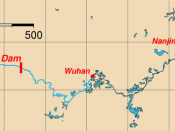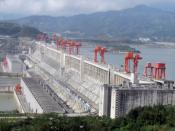China relied heavily on coal during the mid-1990s due to the large deposits of coal that made up nearly 1/5 of the worlds total. South of the Yangtze River production is lower than other parts, but not as little as in the mountainous western areas of China. The abundance of coal led to industry, transport and homes burning coal in one form or the other. As a result many cities experienced severe atmospheric pollution, and China was blamed for releasing 10% of the world's annual greenhouse gases. During this period China was not at all sustainable in its energy usage.
Not all of China's energy came from coal; the rest was produced from oil and hydroelectricity. By 1995 it ranked 2nd in the world for generated electricity with 12 power grids, 35 power plants of which 26 were thermal, 7 hydroelectric (largest being Gezhouba on the Yangtze) and 2 nuclear.
More recently China has taken several major changes in an attempt to be more environmentally friendly and sustainable. The more notably changes are the attempts to close small coalmines, thus reducing the production and various forms of pollution. Current efforts are focused on eliminating irrationally located coal mines within the large state owned coal mines' areas of operation and the mines failing to meet the requirements for reopening following upgrading. In the first for months of 1999 20,125 small coal mines were shut down, reducing output by 81.36 million tonnes, the target was a reduction in output by 250 million tonnes and the closure of 25,800 coal mines due to over supply and environmental safety concerns. The closure of coalmines is a positive step to reducing the number coal fired power plants; this leads to a greater use on cleaner fuels such as gas and oil to compensate the loss...


